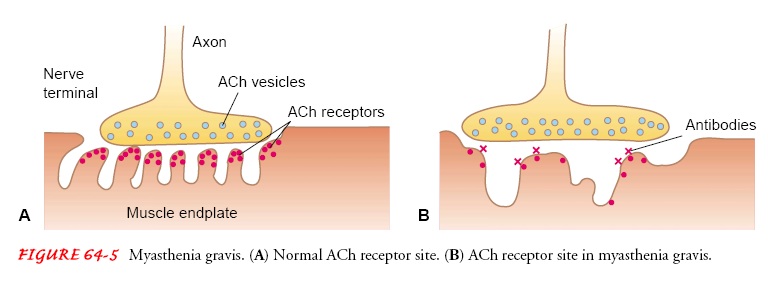Myasthenia Gravis
Definition
An autoimmune disorder
Affects myoneural junction
Weakness of voluntary muscles
Incidence
Women - 20 to 40 yrs
Men - 60 - 70 yrs
Women > Men
Pathophysiology
Autoantibodies directed at the acetylcholine receptor sites impair transmission across the myoneural junction
Fewer receptors are available for stimulation
Leads to muscle weakness
Continued activity
May be due to thymic hyperplasia or a thymic tumor - the site of antibody production
Clinical Manifestations
Diplopia
Ptosis
Weakness of the facial muscles - Bland facial expression
Bulbar symptoms like weakness of throat muscles
Generalised weakness
Dysphonia - voice impairment
Choking and aspiration
Decreasing vital capacity and respiratory failure
Purely a motor disorder with no effect on sensation or coordination
Investigations
Anticholinesterase test - Edrophonium chloride (Tensilon) IV 2 mg at a time to a total of 10 mg - 30 seconds after injection facial muscle weakness and ptosis resolves for about 5 minutes
Atropine 0.4 mg to control the side effects of edrophonium (bradycardia, sweating and cramping)
Acetylcholine receptor antibody titers elevated
Nerve stimulation tests - 15% reduction in action potential in successive stimulation
MRI - thymus enlargement
Medical Management
Pyridostigmine bromide (Mestinon)
Neostigmine bromide (Prostigmin)
Dosage is increased gradually until maximal benefit
Immunosuppressive therapy - corticosteroids - Prednisone
Cytotoxic medications - azathioprine (Imuan), cyclophosphamide (Cytoxan), and cyclosporine reserved for resistant cases
certain medications should be used with caution in myasthenia gravis - antibiotics, cardiovascular medications, antiseizure and psychotropic medications, morphine, quinine beta-blockers, Procaine - patient's dentist informed
Plasmapheresis in exacerbations
IV immune globulin
Surgical Management
Thymectomy - after surgery it may take upto one year
Complications
Myasthenia crisis
Anticholinergic overmedications
Neuromuscular respiratory failure
Nursing Management
Chronic disease - seen in Op - needs patient and family teaching - medication management, energy conservation, strategies to help with ocular manifestations and prevention and management of complications
Keep a diary and note time of deterioration which will help in deciding dosage intervals
Meal times to coincide with peak effects of anticholinesterase medication
Resting before meals
Soft food
Suction should be available
Gastrostomy may be needed to maintain adequate nutrition
Protect eyes from conjunctival xerosis by eye patches, artificial tears
Patching one eye for doublevision
Avoid precipitating factors like, emotional stress, infections (Respry), vigorous physical activity, some medicatins and high environmental temperatures
Sedatives and tranquilizers avoided
Nasogastric tube feeding if needed
ABG, serum electrolytes, I/O chart, weight monitored
1956
1757





